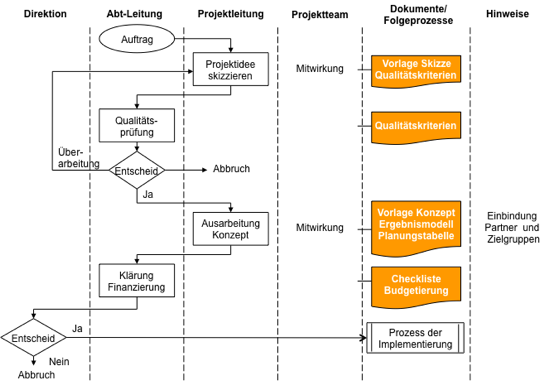
Fachstellen und andere Organisationen in der Gesundheitsförderung und Prävention werden in der Regel als Projektträger oder als Geldgeber mit der Planung, Durchführung oder Bewertung von Projekten konfrontiert. Es gibt wohl kaum Organisationen in diesem Handlungsfeld, die für den Umgang mit ihren Projekten keine Vorgaben machen. Oft sind es einzelne Formulare und Anleitungen für das Erstellen von Skizzen und Konzepten sowie bestimmte Instrumente, die für die Planung, Evaluation und Dokumentation von Projekten genutzt werden. Möglicherweise gibt es auch Verfahrensregeln, die eingehalten werden müssen. Solche qualitätsrelevanten Elemente stellen eine gewisse Einheitlichkeit im Umgang mit Projekten sicher und erhöhen die Planungs- und Rechtssicherheit.
Erfahrungsgemäss sind derartige Vorgaben, Vorlagen und Instrumente in den meisten Organisationen erst punktuell im Einsatz - ein systematisches Qualitätsmanagement für Projekte ist bislang in nur sehr wenigen Organisationen der Gesundheitsförderung und Prävention eingeführt worden. Während Elemente der Qualitätssicherung (Vorgaben, Vorlagen) eher anzutreffen sind, fehlen meist klar definierte Prozesse einer kontinuierlichen Qualitätsentwicklung. Dies würde eine umfassende und kritische, periodisch wiederkehrende und systematische Reflexion der Projektpraxis anhand von Qualitätskriterien bedeuten.
Die nachhaltige Verankerung von Qualitätsentwicklung und -sicherung gelingt nur, wenn in der Organisation eine entsprechende Qualitätskultur entwickelt und etabliert ist. Wesentliche Elemente einer Qualitätskultur in einer Organisation sind:
Die Einbettung von Projekten bei Projektträgern führt dazu, dass zwei unterschiedliche Organisations- und Managementformen mit je eigenen Rollen, Aufgaben und Zielsetzungen aufeinander abgestimmt werden müssen. Wenn die Organisation den Anspruch hat, Qualität systematisch und umfassend zu entwickeln und zu pflegen, muss sie eine Antwort auf die Frage finden, wie sich die Qualitätsentwicklung auf der Ebene der Organisation mit jener auf der Ebene von zeitlich begrenzten Projekten abstimmen und koordinieren lässt.
Falls bereits ein Qualitätsmanagementsystem auf der Ebene Organisation eingeführt wurde (z.B. ISO 9001, EFQM, oder QuaTheDA), stellt sich die Frage, wie sich ein Qualitätssystem für Projekte, wie zum Beispiel quint-essenz im Kontext des vorhandenen Qualitätsmanagements sinnvoll und gewinnbringend nutzen lässt. Projekte verfügen über eine eigene Organisation und formulieren eigene Ziele, die mit entsprechenden Strategien und Maßnahmen realisiert werden. Ein gewisser Grad an Autonomie der Projektorganisation gegenüber der Linienorganisation des Trägers ist notwendig, um den spezifischen Herausforderungen von Projekten angemessen begegnen zu können. Eine kritische Reflexion des Umgangs einer Organisation mit ihren Projekten (vgl. dazu die Bewertungsraster Trägerorganisation und Geldgeber) kann sichtbar machen, wo diese Autonomie zu weit geht und mehr Standardisierung erforderlich ist oder umgekehrt, wo ein allzu zu starres Korsett die notwenige Flexibilität einschränkt.
Der Umgang der Organisation mit Programmen und Projekten kann als Prozess beschrieben und gestaltet werden. Dies führt zu einer Vereinheitlichung bestimmter Aspekte der Planung, Steuerung und Evaluation, was zuweilen als unnötige Einschränkung verstanden wird, aber in der Praxis viele Vorteile hat. Sie entlastet die Akteure, reduziert Doppelspurigkeiten und Missverständnisse, erleichtert den Erfahrungsaustausch und die systematische und kritische gemeinsame Reflexion. In Prozessdefinitionen für den Umgang mit Programmen und Projekten werden die einzelnen Schritte und Zeitpunkte für Entscheidungsfindungen festgelegt, verantwortliche Personen oder Gremien benannt und entsprechende Kriterien, Vorlagen, Instrumente oder andere Hilfsmittel zugeordnet. Dank den Qualitätskriterien und Instrumenten von quint-essenz müssen die verschiedenen Dokumente nicht mehr neu entwickelt werden, sondern können - allenfalls angepasst - direkt eingebunden werden. Hier ein Beispiel für den Prozess der Projektkonzeption, von der Projektidee bis zum Konzept. Prozessdefinition Projektkonzeption. Prozessbeispiele für die Implementierung und Valorisierung von Projekten finden sich im Buch zu quint-essenz (in Deutsch).

Diese Prozessdefinitionen dienen gleichzeitig als Schnittstelle zwischen Qualitätsmanagement-systemen für Organisationen (ISO 9001, EFQM, QuaTheDA,…) und der konkreten Projektarbeit. Qualitätsmanagementsysteme legen mit ihren Normen und Bewertungskriterien fest, dass die unterschiedlichen Aspekte definiert sein sollen, sie bestimmen aber nicht, wie das zu erfolgen hat. Während Normen und Bewertungskriterien den Reflexions- und Handlungsspielraum festlegen, liefert quint-essenz mit seinen Qualitätskriterien und Begrifflichkeiten, seiner Methodik und Instrumenten die Inhalte und Werkzeuge für die konkrete Projektarbeit!